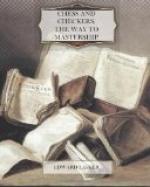At first sight this might seem a violation of the principles, as Pxd5 is a Pawn move which does not further the development of the pieces while Black, in retaking the Pawn, develops his Queen. However, as was already pointed out on several other occasions, the early development of the Queen is not desirable as she is sure to be exposed to the attack of minor pieces. Indeed, White obtains the better game through (3) Kt-c3, Q-a5; (4) P-d4 or (4) Kt-f3, followed by P-d4. Black cannot get his King’s Pawn up to the center [(4) P-d4, P-e5; (5) Q-h5] and in addition he is bound to lose some more moves with his Queen as soon as White has developed his Bishop to d2 threatening a discovered attack through a move with the Knight c3.
II. (1) P-e4 P-e6
With this move Black switches the center from the e-file to the d-file.
(2) P-d4 P-d5
Now White need not hesitate to protect his King’s Pawn with Kt-c3, for Black cannot, as shown in example 1, gain control of the center by exchanging on e4 and playing P-e5.
The advance (3) P-e5 cannot be recommended for the reason explained in example I. Of course, White, being a move ahead anyhow, can afford to make a Pawn move which does not exactly advance his own development, if that Pawn move hampers the development of the opponent to some extent. This would be the case after (3) P-e5, as Black could not develop his King’s Knight to the most natural square, namely, f6. However, the Pawns d4 and e5, though forming a strong center, as long as they are both in place, are liable to become subject to disagreeable attacks which Black can institute with P-c5 and P-f6, and if White cannot maintain his center, then the advance to e5 is mere waste of time.
(3) Kt-c3 Kt-f6
Again White’s King’s Pawn is attacked. The first continuation for White to think of would be (4) B-d3, developing another piece. However, Black can then simply exchange twice on e4 and play P-c5, so that White loses his Pawn center. P-e5 does not seem very good either. It does not lose any time, as Black too has to lose a move retreating with his Knight. But the latter is well posted on d7 from where he assists the contemplated advance P-c5 against White’s center. The best continuation is apparently (4) B-g5, which develops a piece and protects the Pawn e4 through pinning the Knight f6. After
(4) B-g5 B-e7
White finally has to either advance the King’s Pawn or exchange him. The latter seems preferable. The drawbacks to the advance have been discussed before. After the exchange White can develop his King’s Bishop to d3 where he is considerably better posted than the corresponding Black Bishop.




